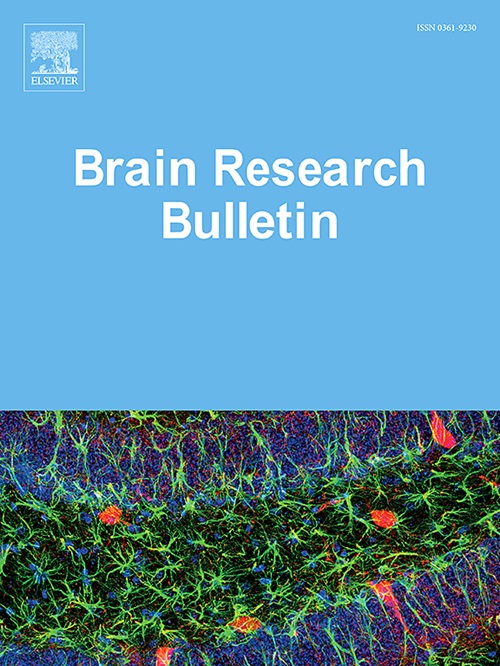BNSTGABA神经元调节自噬减轻抑郁伴胃功能障碍症状
IF 3.5
3区 医学
Q2 NEUROSCIENCES
引用次数: 0
摘要
胃功能障碍在抑郁症患者中十分常见,脑胃耦合机制是其发生的关键。电针(EA)在治疗负面情绪和胃肠道合并症时,可以同时作用于“形”(即身体层面)和“灵”(即心理-情绪层面),实现“形-灵共用药”的治疗效果。其神经机制尚不清楚。我们建立了一个慢性不可预测应激(CUMS)模型,胃电生理和行为结果表明,EA可以缓解抑郁症状,改善伴随抑郁的胃功能障碍。我们发现,CUMS模型抑制终纹床核(BNST)的gaba神经元,而EA干预后BNSTGABA神经元被去抑制。化学激活BNSTGABA神经元可消除cums诱导的抑郁症状和胃功能障碍,其效果与EA治疗相似。此外,转录组学数据显示,CUMS模型小鼠胃组织中存在过度自噬,EA可减轻这种自噬,Western Blot验证EA可能通过调节BNSTGABA神经元改善抑郁症诱导的胃功能障碍,有效抑制胃组织细胞过度自噬。因此,我们的研究描述了一种通过BNSTGABA神经元调节胃细胞自噬从而减轻抑郁症胃功能障碍的神经机制,并为电针治疗伴躯体症状的心境障碍提供了理论依据。本文章由计算机程序翻译,如有差异,请以英文原文为准。
BNSTGABA neurons regulate autophagy to alleviate depression with gastric dysfunction symptoms
Gastric dysfunction is very common in depressed patients, and the coupling mechanism between the brain and the stomach is a key point in its occurrence. Electroacupuncture (EA) can act on both ‘form’ (i.e., the physical level) and ‘spirit’ (i.e., the mental-emotional level) in the treatment of negative emotions and gastrointestinal co-morbidities, realising the therapeutic effect of‘form-spirit co-medication’. The neurological mechanism is not clear.We developed a chronic unpredictable stress (CUMS) model, and gastric electrophysiological and behavioural results suggest that EA can alleviate depressive symptoms and improve gastric dysfunction accompanying depression. We found that the CUMS model inhibits GABAergic neurons in the bed nucleus of the stria terminalis (BNST), whereas BNSTGABA neurons are de-suppressed after EA intervention. Chemical activation of BNSTGABA neurons eliminated CUMS-induced depressive symptoms and gastric dysfunction with effects similar to EA treatment. In addition, transcriptomics data showed that excessive autophagy was present in the gastric tissues of CUMS model mice, which was alleviated by EA, and it was verified by Western Blot that EA may ameliorate depression-induced gastric dysfunction by modulating BNSTGABA neurons, which effectively inhibited excessive autophagy in the cells of gastric tissues. Thus, our study describes a neural mechanism that regulates autophagy in gastric cells via BNSTGABA neurons, thereby alleviating gastric dysfunction in depression, and provides a theoretical basis for electroacupuncture in the treatment of mood disorders with comorbid somatic symptoms.
求助全文
通过发布文献求助,成功后即可免费获取论文全文。
去求助
来源期刊

Brain Research Bulletin
医学-神经科学
CiteScore
6.90
自引率
2.60%
发文量
253
审稿时长
67 days
期刊介绍:
The Brain Research Bulletin (BRB) aims to publish novel work that advances our knowledge of molecular and cellular mechanisms that underlie neural network properties associated with behavior, cognition and other brain functions during neurodevelopment and in the adult. Although clinical research is out of the Journal''s scope, the BRB also aims to publish translation research that provides insight into biological mechanisms and processes associated with neurodegeneration mechanisms, neurological diseases and neuropsychiatric disorders. The Journal is especially interested in research using novel methodologies, such as optogenetics, multielectrode array recordings and life imaging in wild-type and genetically-modified animal models, with the goal to advance our understanding of how neurons, glia and networks function in vivo.
 求助内容:
求助内容: 应助结果提醒方式:
应助结果提醒方式:


